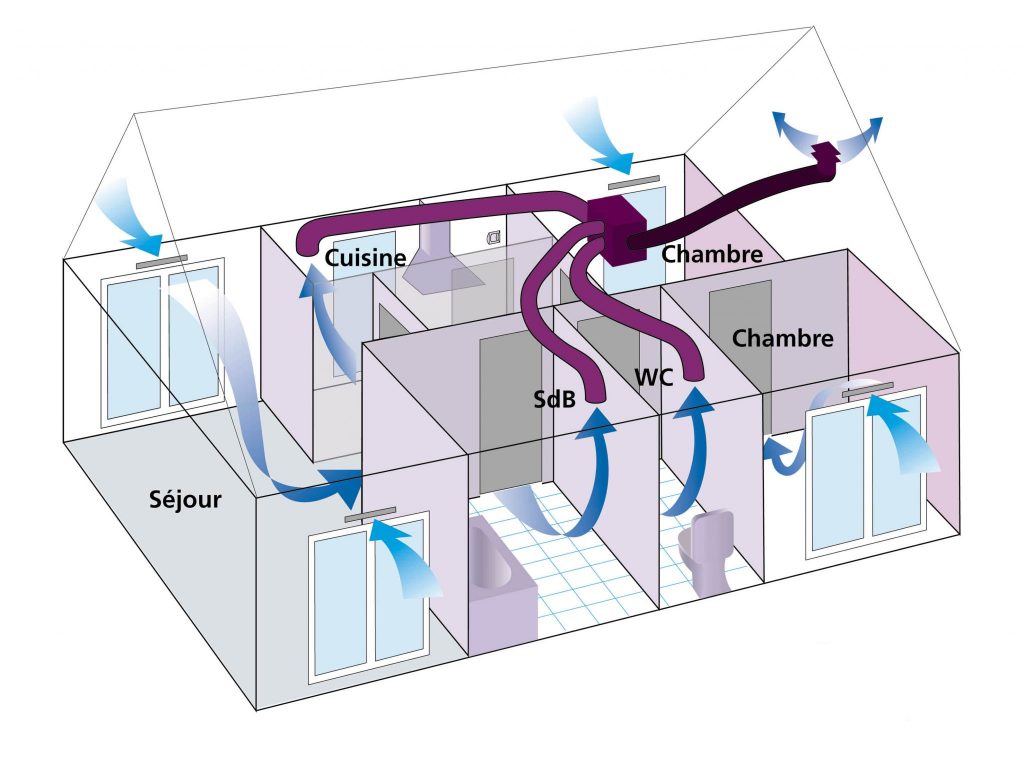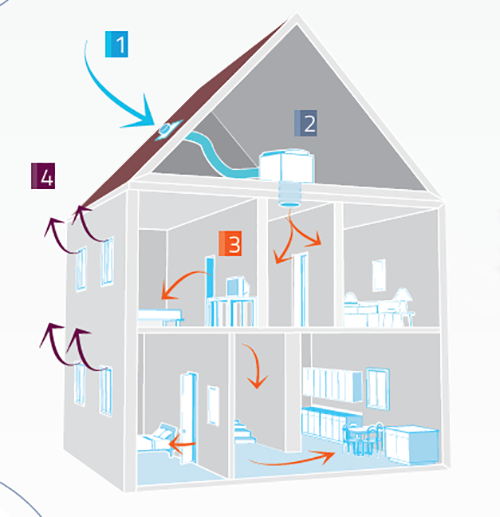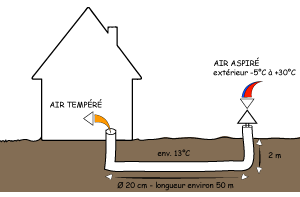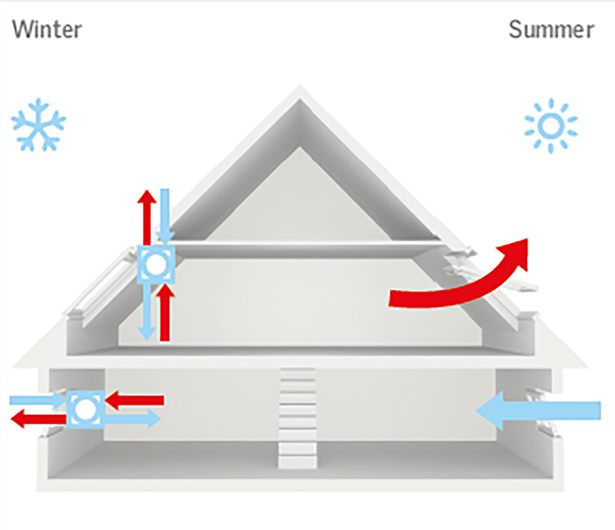Loïc Unternährer, Odile Montarnal, Brian Salamin, Rosa Schnebli
Ventilation
Ventilation is the intentional introduction of (outdoor) air into indoor space. Its primary purpose is to renew the air in the house and thus to ensure good air quality. Ventilation helps to moderate internal temperature, reduce excess moisture, odours, bacteria, dust, carbon dioxide, smoke and other gases and contaminants. This improves the comfort of the inhabitants, decreases their risk for health problems and even improves their productivity. As ventilation is one of the most important factors to maintain acceptable indoor air quality, it is compulsory in every new building since 1982. The ASHRAE standards 62.1 defines the minimum ventilation rates to provide acceptable Indoor air quality (IAQ) for human occupants and to minimise negative health effects.[6] Consequently, before constructing any building, it is primordial to think about ventilation – meaning where the windows and vents are put up, how much the air will be polluted due to machineries, actions in the building as well as to consider the external conditions to provide optimal indoor air quality. [3]
Mechanical (forced) ventilation
Mechanical ventilation is the intentional movement of air into and out of a building using fans, intake and exhaust vents. Mechanical ventilation can provide a constant air change rate independently of external weather conditions, it flow rate is mostly known and precicely measurable but it demands energy and can be very noisy which can be a distraction for the building occupants.[7]
Situations in which we use mechanical ventilation
- The building is too deep to ventilate from the perimeter
- Poor local outside air quality (busy road, highway, industries, …)
- Too noisy outdoor environment so the occupants can’t open windows
- A high urban density prevents wind for natural ventilation
- Privacy, security or sanitary reasons
Main methods of mechanical ventilation [3] :
Pressure system : A fan or other blower which is placed at the inlet blows air through the building. This causes a slightly higher air pressure inside the building compared to the outer atmosphere.
Vacuum system : An exhaust fan placed at the outlet to the vent flue or stack causes an inrush of fresh air. Compared to the outer atmosphere, the air pressure in the building is slightly lower.
Balanced system : This is a combination of the pressure system and the vacuum system; Freshair is supplied while stale air is exhausted.
Fans : Fans ensure air movement inside a room. In summer this increases evaporation on the skin and thus cools down the occupant while in winter it circulates the warm air which rises to the ceiling through the room.
Practical examples of mechanical ventilation
MVS (Mechanical Ventilation System) is composed of a motor, pipes and vents. The system carries the bad air away, using a simple or double flow.

BMV (Blown Mechanical Ventilation) injects treated air (heated, dehumidified, filtrated) from outside into the house. It is easier to set up but it is also more expensive than the MVS. [4]

Natural Ventilation
Natural ventilation is the flow of air which goes through open windows, doors, grilles and other planned building envelope penetrations. It’s largely driven by induced pressure or temperature differences.[9]
Situations in which we use natural ventilation
As natural ventilation doesn’t demand energy we try to use it whenever possibe to reduce environmental impact (pollution) and save energy and money. But we need to consider that the outside air introduced inside can be polluted.[5]
Main methods of natural ventilation
Methods based on wind effects:
One sided ventilation : One main opening where the air goes in and out. The opening is normally placed on a side of the building with a high wind pressure.
Crossed ventilation : Two openings on separated sides of the building. One is placed on a side of the building with high wind pressure where the air will flow in and one on a side with low wind pressure where the air will flow out.
Methods based on temperature effects :
Stack ventilation : A set of openings at a lower level where the air flows in. Once in the room, the air is heated through people and machinery. It rises and exits through an opening at the top. The stack effect or chimney effect, uses the fact that, because of a difference of density between cold air and hot air and the Archimedes thrust, a flow is generated with cold air – heavier – which falls and hot air – lighter – which climbs. This principle is a fundamental principle for ventilation, especially for natural ventilation.
Atrium ventilation : Very similar to stack ventilation but on multiple storey buildings. [5]
The choice on which of these methods are used and where the openings are placed depend highly on the geometry of the building and the wind supply. If we are in a city where there is not much wind due to a too high building density, the stack ventilation based on the difference of temperature will work better. At the opposite, for a house isolated and with a restricted access to electricity, it will be clever to use a methods of ventilation which is based on wind. But methods based on the temperature difference have some significant benefits : They do not rely on wind, are easier to control and have a more stable air flow. But during the windiest days stack methods are less efficient than the ones based on wind effects. [9]

Provencal well: A technology of more elaborate natural ventilation
Outside air is injected in a pipe network buried at 1.5 m under the surface. As the soil temperature is constant along the year (around 10-15°C in our latitude), the air will be heated or cooled by exchanging heat with the soil. The tempered air is introduced in the house where stale air will be driven out.

Best Option
As we have seen previously, ventilation is important and depends on many factors such as location, wind exposition, outdoor pollution, etc. Therefore we can’t have an universal solution that is applicable for every building. Economically and ecologically, we will prefer natural ventilation but, in majority of cases, natural ventilation can’t be applied alone or at all. A very common method to ensure an optimal enery use is hybrid ventilation which is a mix of natural and mechanical ventilation. One example, illustrated in the image below, is the use of mechanical ventilation with a heat recovery system during winter, which reduces the demand for heating while in summer natural ventilation is used.

Conclusion
In conclusion, ventilation is a really important part to ensure indoor air quality. There exist natural or mechanical ventilation but most of the time they are combined to a hybrid ventilation system, to ensure a good efficiency. Ventilation can be more or less complex per example with heat recovery systems, filtration and other added functions. Our aim is to optimize the system in efficiency in relation to the costs, taking into account the constraints from the outside environment, form of the building, special needs for the function of the building and it’s localisation.
Bibliography
[1] Velux, “Ventilation and ventilation systems”, [online]. Available at the address : https://www.velux.com/what-we-do/research-and-knowledge/deic-basic-book/ventilation/ventilation-and-ventilation-systems
[2] Studio B ventilation ,“Natural ventilation”, [online]. Available at the address : http://uol-ventilation.weebly.com/natural.html
[3] Ooreka, “La ventilation mécanique contrôlée”, [online]. Available at the address : https://vmc.ooreka.fr/comprendre/ventilation-mecanique-controlee
[4] MaPetiteEnergie, “VMI : la ventilation mécanique par insufflation, qu’est-ce que c’est ?”, [online]. Last update : 22.07.2020. Available at the address : https://www.monpetitforfait.com/energie/aides/vmi-ventilation-mecanique-insufflation
[5] “Natural ventilation of buildings,” Oct. 2020. [Online]. Available : https://www.designingbuildings.co.uk/wiki/Natural_ventilation_of_buildings
[6] ASHRAE, “ANSI/ASHRAE Standard 62.1-2019 : Ventilation for Acceptable Indoor Air Quality”, [online]. Available at the address :https://www.ashrae.org/technical-resources/bookstore/standards-62-1-62-2
[7]Wikipedia, “Heating, ventilation, and air conditioning”, [online]. Last update : 25.11.2020. Available at the address : https://en.wikipedia.org/w/index.php?title=Heating,_ventilation,_and_air_conditioning&oldid=987007944
[8] Innowood, Architecture and Design, “How do ventilated façade systems work”, [online]. Last update : 07.11.2016. Available at the address : https://www.architectureanddesign.com.au/suppliers/innowood/how-do-ventilated-facade-systems-work#
[9] Wikipedia, “Passive ventilation”, [online]. Last update : 16.11.2020. Available at the address : https://en.wikipedia.org/w/index.php?title=Passive_ventilation&oldid=989023140
[10] Image : “Illustration of a provence wall”. From Maison-nature fr. Available at the address: http://maison-nature.fr/images/helios/schema_puits_canadien.png
[11] Image : “MVS simple flow”. From batinea. Available at the address : https://www.batinea.com/blog/wp-content/uploads/VMC-Simple-Flux.jpg
[12] Image : “BMV”. From Idepro-habitat. Available at the address : https://www.idepro-habitat.fr/wp-content/uploads/2018/07/principe-ventilation-vph.png